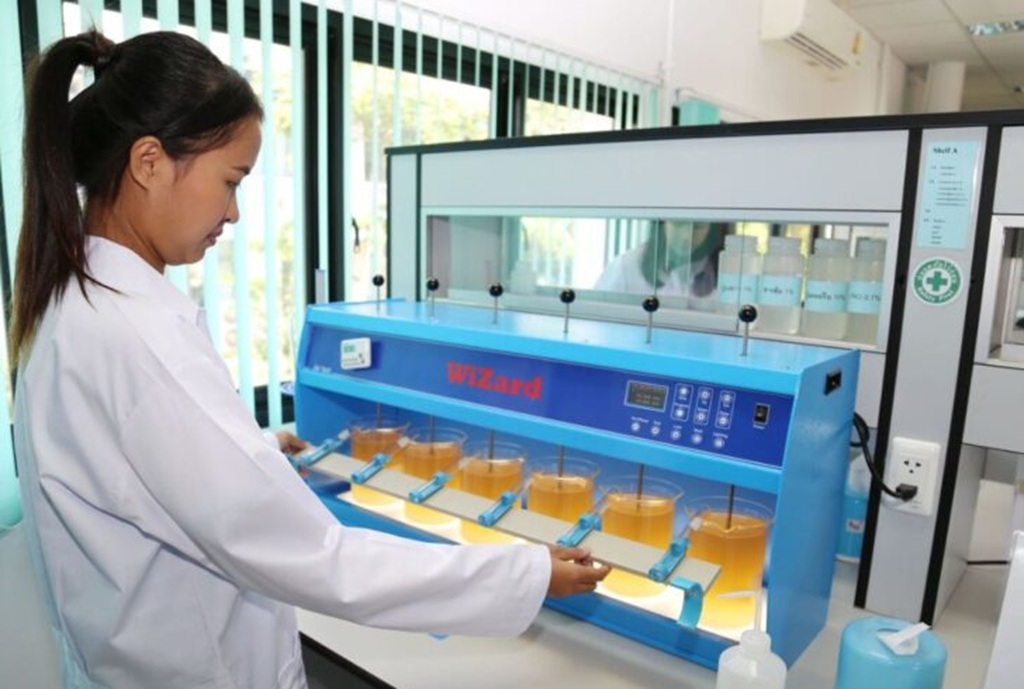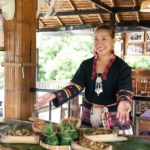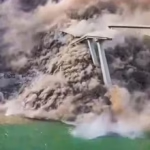CHIANG RAI -The Provincial Waterworks Authority (PWA) in Chiang Rai plans to switch its raw water source for city tap water from the Kok River to the Lao River after traces of arsenic were found in Kok River samples last year.
Tests show treated water still meets health standards, but many residents remain uneasy. Some households have stopped drinking or using tap water and want the state to speed up the move to protect public health.
On November 12, 2025, Apisak Savasdirak, manager of the PWA Chiang Rai branch, told The Active that the relocation plan stems from the detection of arsenic in the Kok River. Although levels are below the Department of Health standard, the finding has shaken public confidence.
Mr Apisak said, “We understand the public’s concerns. Our treatment process meets safety standards, and quality results are reviewed regularly, but our duty is to provide clean, safe water. We have upgraded treatment steps and started planning to relocate the raw water source to rebuild trust.”
Extra treatment steps to reduce arsenic and heavy metals
Apisak explained that the plant previously used a standard process with alum and lime. After detecting heavy metals, the team added pre-chlorination, which doses chlorine before coagulation to help separate metals from the water.
They also introduced two additional chemicals, polyaluminum chloride (PACl) and sodium hydroxide (NaOH), to speed up coagulation so arsenic bound to sediment can settle more effectively.
Most arsenic in the Kok River binds to suspended sediment. If we make that sediment settle faster, the water becomes clearer and safer. After pre-chlorination and coagulation, we add an intermediate chlorination step to disinfect again and catch any residues before filtration.
Right now, operators control turbidity more strictly than required. Before filtration, turbidity is kept at no more than 4 NTU, and after filtration, finished water must be at or below 1 NTU. For comparison, raw water from the Kok River often measures around 180 NTU, and during floods, it once peaked at 10,000 NTU.
Chemicals used meet drinking water standards.
Responding to questions about chemical use, Apisak said every substance added is an approved water treatment chemical and is safe when used correctly.
The Provincial Waterworks Authority does not use hazardous chemicals. They use standard water treatment aids, adjusted in dose to fit current raw water quality. Our lab supervises the process, and we submit water quality results to the Department of Health on a routine basis. There are no harmful residues for consumers,” he said.
Even though current arsenic levels in treated water are well within limits, with tests below 0.001 milligrams per liter compared to the Department of Health limit of 0.01 mg/L, many residents still do not accept the Kok River as a source.
“When people do not feel at ease, we have to respond. We decided to push ahead with moving the source from the Kok River to the Lao River. The plan proposes a budget of 2,176 million baht. The intake and plant would be near Mae Lao Weir, and water would be sent about 34 kilometers to the city,” said Apisak.
The new system would also extend service along the transmission route, allowing communities outside the current network to access clean water. It is designed to support growth from 41,539 households in 2025 to 66,639 households in 2046.
Budget and timeline
The project is being prepared for submission in the 2028 fiscal year. “In fiscal 2027, we are preparing the proposal and feasibility study. If approved, construction could start in 2028 to 2029, depending on budget allocation and contracting,” Apisak said.
As a short-term measure, the PWA requested 5 million baht to upgrade chemical dosing and control systems at the Wang Kham plant. The goal is more accurate dosing and faster response if raw water quality changes while the relocation plan moves forward.
For Mae Sai District, the branch plans a similar shift. The area will phase out raw water from the Sai River, which has been affected by upstream mining, and produce water from the Mekong at Chiang Saen, then pump it to Mae Sai.
“Producing at Chiang Saen and supplying Mae Sai will reduce risks from upstream mining across the border,” Apisak noted.
The delayed start is tied to the state budget cycle.
The Government is reviewing the 2027 budget now, so we could not include the project this year. We will submit in 2028. This is a budgeting process issue, not an internal delay,” he said. Stressing that the current system can manage the Kok River’s raw water and keep treated water safe.
Kok River is still usable, but public confidence has dropped
When asked why move the source if the plant can meet standards, Apisak was direct. People do not accept the Kok River anymore. While operators can treat the water to meet health limits, the public’s distrust means the agency must adapt. The move is about restoring confidence, not an inability to produce safe water.
He added that relocation aligns with national policy to expand access to safe water nationwide. As a Chiang Rai native, he believes the PWA can still handle water from the Kok today, but restoring the river long term likely requires cross-border cooperation.
“The Kok could recover if Thailand and neighboring countries agree on mining standards and require treatment before discharge. We do not know how the other side manages waste today, so we need a backup plan,” he said.
Mr Amid worries over heavy metals in the Kok River, many residents have changed their daily habits. Mathuros Plengsai, who lives in Mueang Chiang Rai District, said her family stopped drinking tap water months ago, despite official reassurances.
“We use tap water for everything, washing, brushing, watering plants, giving to pets, except drinking,” she said, adding that trust started to drop early this year, after reports of contamination surfaced.
“Officials gave explanations, some even drank water on camera, washed their faces to prove a point, but we have not seen long-term studies. What happens if we drink this water for 10 or 20 years? Will we get cancer? What about pets and our vegetables?” she asked.
“Most people do not have wells. Everyone depends on tap water. Even if we worry, we still have to bathe, wash, and clean with it.” she said. She also raised ongoing system issues, such as outages during floods and unstable service.
“When the power went out during the flood, water stopped for seven days. After the flood, there are maintenance shutdowns almost every month. If the source moves, I hope the overall system improves too,” she said. On the relocation plan, now under state review, she felt relief.
“This is not just about heavy metals. It is a long-built problem. If the headwaters are polluted, we at the end bear the cost. Moving the source is the only workable fix right now,” she said.
She reflected on how Chiang Rai, once proud of its clean water, reached this point. “We grew up drinking from the Kok, playing in it. It is the lifeline of our town. Now it is something we have to be careful with. Water is a basic need, and I feel angry that it was not protected,” she said.
She called on the government to tackle the cause, not just the symptoms. “If someone dumps toxins into the headwaters, that endangers everyone downstream. The state must act. Life matters more than money,” she said.
She believes upstream mining across the border is a major driver of the problem. “Developed countries do not allow these practices because they leave toxic waste. Our region still does because of money. Please stop before it is too late,” she said.
Even so, she still hopes the river can recover. “If the headwaters heal, the rest will follow. One day, the Kok could run clear again, but we have to stop the harm first,” she said. In her view, people need real fixes, not press statements. Clean water should be a basic right in Chiang Rai again.
“Chiang Rai Water is not safe; no one dares to use it.”
Ms Rattikorn Saengsuwan, a resident of Chiang Rai Municipality, said many households have switched from groundwater to tap water in recent years. After news about Kok River contamination, confidence plunged, especially when some sampling sites showed values above limits.
“We used to use tap water and then filter it for cooking and drinking. After the reports, and when fish in the river started dying, our community stopped drinking tap water. We now buy all the water for cooking and serving customers at our restaurant. Costs have risen a lot.
Even filtered tap water smells strongly of chlorine, and sometimes the smell stays after boiling,” she said.
She said residents who track local test results still see readings over standards in some areas month after month, which keeps doubts high.
Skin irritation has also become a worry. “After showering, I get rashes in skin folds. I first thought it was the weather. The doctor told me to stop using tap water. After switching to stored water that we let settle first, the rashes improved. In our village, almost no one drinks from the tap anymore. Each home orders water deliveries at least twice a week,” she said.
In her view, upstream mining drives the damage. “If we do not fix the source, the problem will never end. River recovery will take years. Probably at least a decade before it is clean again,” she said. She supports moving the source to the Mae Suai Dam or the Lao River.
“If we switch to another river, people will feel safer. The Lao River does not receive water from Myanmar like the Kok does. Most locals agree the Kok will not bounce back soon,” she added. On a personal note, she felt heartbroken. “The Kok River is part of our identity.
I never thought we would have to change our water source. Now we cannot even drink from it. It hurts,” she said.
Calls to fund mountain water systems for villages
Village water systems along the Kok have also been abandoned. Pratthakorn Kanreo, the headman of Mae Yao Subdistrict, said residents in Moo 4, Ban Rim Kok, stopped using their village system more than a year ago after flood damage and arsenic reports. Over 400 households remain without a working system.
“Rim Kok was hit hard by the 2024 floods. The village water system was damaged. Then came the arsenic reports. People refuse to use water from the Kok now,” he said.
Before the flood, the village pumped river water into filters and distributed it to homes. The system broke and has not been repaired. Funding has not arrived, and news about contamination deepened fear.
“People do not want to go back to Kok water even for washing. We have pushed for a mountain water system instead. Upland sources are cleaner and safer,” he said.
He submitted a proposal to the Community Organizations Development Institute (CODI) for a mountain water project more than a year ago and is still waiting. “We keep following up with CODI. They said approval would come, but there is still no clear answer,” he said.
Meanwhile, families must buy drinking water. What used to be free, or about 100 baht a month, now costs 500 to 1,000 baht a month. The burden hits low-income households and farmers hardest.
The municipality sends water trucks from time to time. Residents still worry about the quality because they do not know the source. “People must use what is delivered. We cannot live without water,” he said.
In Mae Yao Subdistrict, three to four villages still lack a functioning water system, including Ban Pa Or and Ban Rim Kok. Together, they represent several hundred households. On the plan to move the raw water source to the Lao River and expand the PWA network, he said, there has been no official notice.
“If the line extends to Rim Kok, we want to be included. It is the option people prefer,” he said.
Pratthakorn said he has attended meetings and filed complaints with several agencies, including the Deputy Prime Minister, the Minister of Natural Resources and Environment, and parliamentary committees, asking for urgent help. He has seen no clear progress.
“Four hundred households still lack tap water. People have to buy drinking water and use water they do not trust. This is urgent. Water is a basic need,” he said.
Source: The Active

















